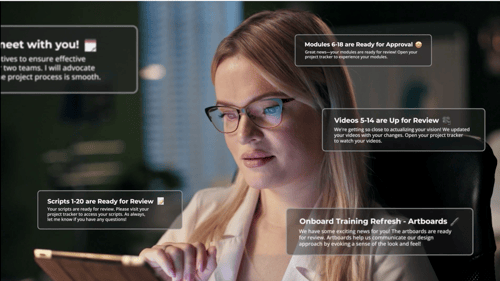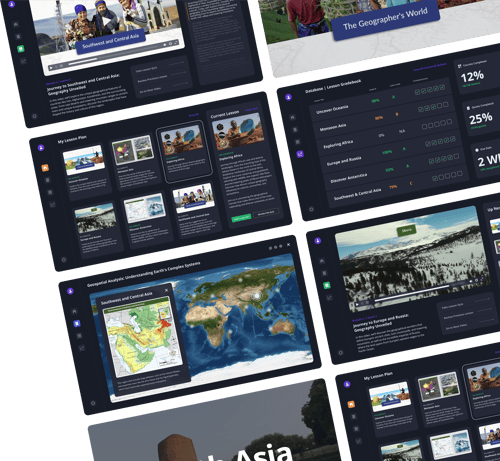E-Learning has exploded in popularity in recent years. It’s applicable to and being used in a wide variety of contexts, including higher education, alternative education, workplace training, and upskilling. The odds are high that you have participated in more than one of these types of e-learning, and the odds are better that you already know that not all e-Learning experiences are created equally.
Creating a welcoming and inclusive environment for new employees is crucial for their successful integration into the workplace. A well-designed onboarding process plays a pivotal role in helping new hires feel valued, supported, and knowledgeable about their roles and responsibilities. But oftentimes, the onboarding process is dry, uninspiring, and leaves the employee hoping they made the right choice. However, you can take the employee experience to the next level by incorporating engaging training videos and company culture videos into your onboarding program.
Whether you are an HR professional seeking to enhance your company's onboarding practices or a business owner looking to optimize your new hire’s productivity and engagement, this article will provide valuable insights and strategies for leveraging the power of video in your onboarding journey.
Why Use Video for Onboarding?
There are several advantages to incorporating videos into your employee onboarding process that surpass the limitations of traditional methods. One of the key benefits is flexibility and accessibility. Unlike live orientations or in-person training sessions, videos can be accessed at any time and from anywhere, allowing new employees to review the onboarding material at their own pace and convenience. The ability to access the educational content whenever employees need a refresher or clarification can reinforce their understanding of the information and ensure an easier transition into their new role.
Onboarding videos eliminate the need for synchronous training sessions, which can be challenging to schedule and may not accommodate the diverse learning styles and time constraints of new employees. On-demand video training is a self-directed and active learning experience that promotes better knowledge retention and application.
In addition to their flexibility and accessibility, onboarding videos offer a dynamic and engaging way to share information with new hires. Visuals, audio, and storytelling techniques can capture the attention and interest of employees, making the experience far more memorable. Unlike traditional text-based materials or slide presentations, videos evoke emotions, convey tone and enthusiasm, and bring concepts to life through visual demonstrations or real-life scenarios. By utilizing engaging visuals, animations, and relevant examples, onboarding videos can effectively communicate important information and ensure that new hires not only understand the content but also connect with it on a deeper level.
Onboarding videos can help standardize the onboarding process by guaranteeing that each new hire receives a consistent experience. By delivering the same information, policies, and procedures through videos, companies can certify that each new employee receives high-quality information. Furthermore, standardization can set the tone for fairness and equality within the organization. Every new hire has the opportunity to access the same content which eliminates the potential for inconsistencies or biases that may occur when relying solely on verbal or individualized onboarding approaches. By presenting information in a standardized format, companies can maintain a degree of objectivity and equip all employees with the same foundational knowledge. This can foster a sense of inclusivity, fairness, and a cohesive organizational culture where employees operate from the same baseline of understanding, regardless of location or department.
Onboarding videos also provide scalable solutions for effective employee orientation. Video training can be particularly helpful in cases where multiple new hires join the company at the same time or in geographically different locations. By using videos, companies can streamline the process by bypassing repetitive and lengthy in-person training. This scalability saves time and resources and makes certain that the information is consistent and impactful.
Onboarding Video Opportunities
There are several types of onboarding videos that can enhance employee orientation. For example:
Company Overview Videos:
An onboarding video that provides an overview of a company's history, mission, and values can be an effective tool for welcoming and integrating new hires into the company culture. It allows the leadership to set the tone so that employees at any level can be bought into the organization early. By understanding the company's history, new employees can gain insights into the company's roots, achievements, and milestones. A clear understanding of the company's mission and values can encourage employees to align their own goals and values with that of the organization. This can lead to increased employee satisfaction and engagement, which can ultimately translate into higher employee retention rates.
The example below is from a series of onboarding videos that explore the ethos behind the company’s delivery of broadband network. The series dives into the company’s core values and dedication to connecting rural communities together. These videos encourage a shared purpose among new employees that can improve teamwork and collaboration. Additionally, the video series helps new hires see how their roles fit into the company’s larger objectives, creating a deeper sense of belonging.
Team Member or Manager Introduction Videos:
Team Member or Manager Introduction videos can give new hires better insight into the company’s structure and who they will be working with. Team videos feature managers and key team members, their roles and responsibilities, and how they fit into the vision of the company. These types of videos provide new employees with a visual guideline of the company’s organizational structure and can make them feel more comfortable in their new environment. This kind of video may improve communication within the organization.
The example below weaves together a company overview and executive leadership introductions. In the video clip, the Chief Sustainability Officer discusses how manufacturing initially began in the US but expanded to several different countries. The CSO introduces the founder and discusses his championing of sustainability and biomimicry. Throughout the video, it’s made clear that the shift to those concepts heavily influenced all parts of the company – from designing to manufacturing, office design, and more. After watching, the new hire understands how their role plays a significant part in the larger goals of the organization.
Project or Program-Specific Videos:
Project or program-specific onboarding videos are an excellent way for a company to provide tailored information to new hires about projects they will be working on. This type of video can illustrate the goals and expectations of the project or program, as well as the tools and resources they need for success. Video content that contains project or program-specific information enables new employees to gain a solid understanding of what’s to come before starting. In the instance below, the staff discusses the purpose of a specific teaching program and ways to implement key concepts. This program-specific video promotes new hire confidence and preparedness, which can lead to a more successful program outcome.
Policy Explainer Videos:
Policy explainer videos are a great additional resource to a company’s onboarding process, especially when it comes to topics such as health, safety, compliance, operations, and other important policies. Videos can utilize visual aids and real-life scenarios to better explain the policies vs. traditional text-based handbooks. Using motion graphics or animation, a video can help employees understand complex information in a clear and concise manner, By visually demonstrating safety protocols, emergency procedures, or IT policies, employees are more likely to understand and adhere to them, thus reducing the risk of accidents, security breaches, or legal issues. In the example below, the company uses an eye-catching flowchart to show systems of support for communities dealing with disasters.
Additionally, policy explainer videos can help establish positive company culture by demonstrating the importance of safety, compliance, and other policies to the overall success of the organization.
Software Training Videos
Video training has become an increasingly popular way to introduce new employees to a company's software and technology. Gone are the days of lengthy manuals, tedious training sessions, and technical problem-solving on the spot. Videos turn educational content into engaging material that demonstrates the best practices and common use cases of company software and platforms. This brings new hires up to speed on the technology they will use in their new role. In the instance below, the company utilized visually compelling demonstrations and step-by-step instructions to offer a comprehensive overview of the software's functionalities and highlight the most efficient ways to utilize it. This helps new users to ramp up their skills and technical knowledge at a quick pace, ensuring a smooth transition into their roles.
Create Effective Onboarding Videos
Use the following strategies to ensure that your onboarding videos are impactful, memorable, and set a positive tone for new employees' integration into your company:
-
Keep it simple: Consider the information overload that new employees experience during the onboarding phase. Keep videos clear and concise to prevent them from feeling overwhelmed. Organize the content in advance and divide it into key points to make certain they can easily absorb and retain the information. Additionally, shorter videos encourage better attention and engagement, ensuring that the most important messages are effectively conveyed.
-
Make it pop: Use visually appealing elements to keep new employees engaged and interested in the content. If an onboarding video only uses text on screen (TOS) and static images, then it will just feel like a PowerPoint in motion. However, thoughtful graphics, animations, and storytelling techniques can illuminate complex concepts, create meaningful learning experiences, and make the content more relatable
-
Be real: Use a friendly and welcoming tone to foster a positive atmosphere for new employees. A conversational style can help new hires feel comfortable, supported, and valued from the start. As a bonus, use scenarios or testimonials from current employees to encourage connection and promote authenticity. Real stories from real people highlight company culture and show that the organization cares. Ultimately, a warm and authentic tone can create a positive onboarding experience and help to build rapport between the new hire and the organization.
RELATED: From Snooze to Sizzle: 7 Ways to Boost Learning Video Engagement
Ready to Create Your Onboarding Video?
Enhance your onboarding process by integrating corporate training onboarding videos into your process. By implementing these tips, you can create an outstanding experience that fosters a sense of comfort and engagement among new hires. Whether you need to create one or 100 videos, NextThought Studios has perfected the process that has helped brands like Amazon, Airbnb, and more communicate with effective video. Together, we can create impactful videos that empower new employees and set them on the path to success.

NextThought team
NextThought transforms workplace learning through creative technology and engaging media. We're fortunate to partner with some of the top organizations in the world to make their educational training content remarkable and effective.
Recent Posts

What Can Go Wrong With A Custom Training Project? (And How NextThought Makes It Go Right)
August 5, 2025 1 Min Read

How Much Does a Custom Content Development Project Cost?
July 9, 2025 3 Min Read

The 6 Best Educational Video Production Companies (2025)
February 28, 2025 9 Min Read
